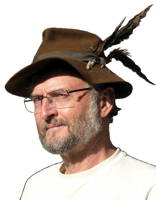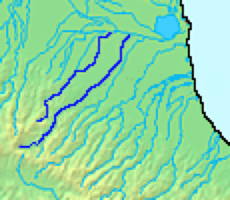
|
The Society of Folk Dance Historians (SFDH)
Folk Dances
[
Home |
About |
Encyclopedia | CLICK AN IMAGE TO ENLARGE |

|
 Geo: Santerno Valley and Sillaro Vlley of Italy.
Geo: Santerno Valley and Sillaro Vlley of Italy.
I shall present hereunder the updated index of the dances of these two valleys.
The corpus of the research was achieved from 2001 and 2006, and then, parallel to the teaching of the rescued dances to local groups, the research continued up to 2012; after that, nothing notable was found. The elderly people interviewed in the first years – when they were over 90 – had in the meantime passed away. The first note to be taken into account is that a new style of dancing "liscio dance" ("smooth dance") took place in the 1960s, so that the local tradition of "ballo staccato" was interrupted in the years 70-80-90s.
From the 70s to the 90s ethnomusicologists went around, and, for example, did a great job in the Savena valley and even rescued many dances in the eastern part of the Region "Romagna." Now you are asking which role I play in all this. Well, at the end of the 90s, when I was around 50 years of age, I played fiddle in a vocalist group that rescued dialect songs, and I had friends who started to follow courses of Balkan dance. I spoke fluent French, so I decided to spend the summer holidays in France, with our growing little daughter.
At the end of the 90s we appeared in big festivals such as the one in St. Chartier and another called "Gran Bal d'Europe" in Gennettines. I encountered many Bourées, dances from Brittany, from Ireland, and so forth. So, by the year 2000, with a friend accordionist, Mauro Grassi, we decided to rescue the local "forgotten" dance repertoire, instead of running after somebody else's dances.
We both spoke local dialect, and Mauro knew every square yard of the valley, so we could interview many elderly people. Speaking the dialect meant that the interviewed people could open up, avoiding any kind of "distance" such as would come with a tape recorder, or speaking standard Italian. Many of them did dance in their youth to the "liscio" music, a kind of commercial music introduced after World War II, but all of them had seen a mother, aunts, or elder sisters dance the "staccato." But before the narration gets too long, let us distinguish two categories in the following list of rescued dances.
The "pure" dances of the list are written in capital letters; they were reconstructed on the basis of the information received. The lower case titles refer to "other" dances, for which we got the music from a tape or written scores, but with no witness to the original choreography. In the latter case, during workshops, dances to this music was choreographed by the Alidosi Dancers group in Castel del Rio. The figures were borrowed from staccato dances already existing in Romagna, from neighboring valleys.
I would like to emphasize that choreographed Manfrine and circle-polkas must be very easy, always with a partner change, in order to meet a basic need: a dance belongs to all people of the village and in particular every boy should meet every girl of the circle, as in any social event, even for exchanging messages with a brief glance, all this before the upcoming of the couple dances after World War I.
The "type" of dances of the two valleys, and in the whole Romagna region are Saltarello, Manfrina, Giga, Trescone, Sotis, and some rare dance types.
The Mac Trio (accordion, fiddle, guitar) recorded the repertoire of 55 tracks in recording sessions between 2007 and 2010 – on 4 CDs.
VIDEOS
This video on YouTube introduces this whole repertory: Valzer dei Saluti.
After recording for eight years in the local fairs and church festivities, the dance group performed in public to music by "Orchestra dei Superstiti of Val Santerno" (founded by Umberto Scala and Remo Roncassaglia in the late 1980s). Notice the fact that you could not join the Orchestra if you were younger than 70; I was allowed to join just as a junior member, giving them the entire corpus of scores of the rescued music: Orchestra dei Superstiti di Val Santerno and also on Facebook.
DANCES
IF A LINK DOES NOT WORK, SEARCH YOUTUBE FOR THE NAME OF THE DANCE
Santerno Valley
VENEZIANA of SAN PELLEGRINO
http://youtu.be/35mIWA8j9lU
SALTARELLO of SAN PELLEGRINO
http://youtu.be/tai1uuO8YT8
TRESCONE of SAN PELLEGRINO
https://youtu.be/RpJNVPNyzsg
LOMBARDINA of SAN PELLEGRINO
http://youtu.be/s4dX50sU-bU
GIGA of SAN PELLEGRINO
http://youtu.be/4oxdXkbRq
A TRESCONE of CASTEL DEL RIO
http://youtu.be/-Gxj8BHBJRY
GIGA of CASTEL DEL RIO
https://youtu.be/9t4ZkUYU-Fc
SOTIS of CASTEL DEL RIO
https://youtu.be/YYuT3K-cNNU
SALTARELLO of CASTEL DEL RIO
https://youtu.be/SA_2sI9aq08
MULNESA of CASTEL DEL RIO
https://youtu.be/b7vCPt6dBhM
SOTIS of CASALFIUMANESE
https://youtu.be/JvlPpGQ_D6E
RONCASTELLA (danced all over in Santerno Valley)
https://youtu.be/ZMU97Pugk2k
Sillaro Valley
The dances of Sillaro valley were not rescued all at once. Trescone, Treccia, and Polka came first. Later, Saltarello and Giga, because we knew accordionist Giuseppe Chiusoli.
TRESCONE of SASSOLEONE
https://youtu.be/XEKWMQjavGw
TRECCIA of SASSOLEONE
http://youtu.be/dctVye5ROnI
POLKA of VALSILLARO
https://youtu.be/llAbpPke15U
GIGA of VALSILLARO
https://youtu.be/ofMXPqd6rQk
SALTARELLO of VALSILLARO
https://youtu.be/JO8Pnf6nJOw
Index of Accessory Dances
Valzer dei saluti (also called Valzer di Peppino – Peppino's Waltz)
https://youtu.be/-Bh1QA3brPU
Polka de zupì
https://youtu.be/XkTvfJqdkzQ
Polka di sgadur ed tranel
https://youtu.be/6vu5_-2s4HM
Polka di aldì
https://youtu.be/TcTgaNnMYkA
Polka "al ragazi de Pungel"
https://youtu.be/F77Xz7IE2mI
Manfrina intarzeda
https://youtu.be/kJ59YYT50W0
Manfrina per tre coppie (coreography borrowed from Premilcuore)
https://youtu.be/5WHj-uTdn2M
Manfrina romagnola (coreography borrowed from the "Vanderina of S.Giovanni Marignano")
http://youtu.be/ZRNjET634ZU
Ballo sulla piva
https://youtu.be/D_z7cxZEGiw
Monecò of Santerno Valley
http://youtu.be/1VpJN46gDKc
Russiano of Castel del Rio
https://youtu.be/I5FJDM304kg
Manfrina of Passogatto (authored music, choreography by J.C. Battilani)
https://youtu.be/v9YN00WBSxk
Ballo del cappello (carnival dance)
https://youtu.be/RQtIPFa4OkY
Bersagliera of Santerno Valley
https://youtu.be/6tQw4C1oMEk
"Raspa," Santerno Valley version
http://youtu.be/-sp0Q3QvOqk
Spiru, Santerno Valley version
https://youtu.be/jVpZJnqU4vc
Buliron, Santerno Valley
https://youtu.be/oqSdys5Cdcs
Galoppa, Santerno Valley
https://youtu.be/By8YbyKV87w
DOCUMENTS
- Folk Dances in Italy, an article.
- Italy, a country.
Used with permission of the author.
This page © 2018 by Ron Houston.
Please do not copy any part of this page without including this copyright notice.
Please do not copy small portions out of context.
Please do not copy large portions without permission from Ron Houston.